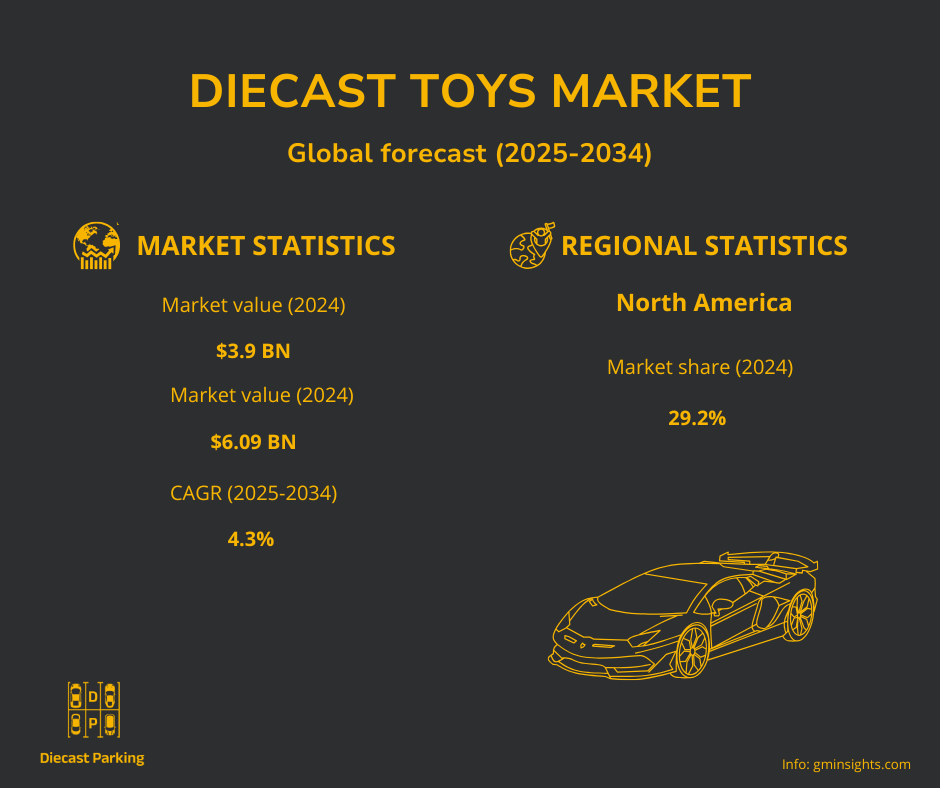The Future of Diecast Toys: Market Trends, Growth, and What’s Driving Demand
Diecast Toys Market Overview
The diecast toys market has been experiencing consistent growth, driven by increasing consumer interest in collectibles, nostalgia, and emerging trends in sustainability and customization. In 2024, the market was valued at approximately USD 3.9 billion, and it is projected to grow steadily, reaching an estimated USD 6.09 billion by 2034, with a compound annual growth rate (CAGR) of 4.3%. This expansion is fueled by a growing number of collectors, rising demand for limited-edition models, and advancements in manufacturing that allow for greater detail and customization.

Key Market Drivers
1. Nostalgia and Retro Trends
One of the primary factors driving the growth of the diecast toys market is the resurgence of nostalgia-driven purchases. Vintage-style models, reissues of classic designs, and collectibles inspired by pop culture franchises have attracted both seasoned collectors and new buyers. Well-known brands such as Hot Wheels, Matchbox, Dinky Toys, and Tomica continue to benefit from this trend by reintroducing popular models from past decades.
Additionally, collaborations with film and entertainment franchises-such as Fast & Furious, Transformers, and Marvel-have contributed to increased demand. Limited-edition releases and highly detailed replicas of vehicles from movies, video games, and real-world motorsports further entice collectors, driving market growth.
2. Sustainability and Eco-Friendly Practices
With growing environmental concerns, toy manufacturers are increasingly adopting sustainable practices. This includes reducing plastic in packaging, using recycled or eco-friendly materials, and improving production methods to minimize carbon footprints.
According to a survey by The Toy Association, about 73% of parents prefer toys made with sustainable materials or produced using environmentally friendly manufacturing processes. Diecast toy manufacturers that incorporate sustainability into their business strategies are expected to gain a competitive edge in the coming years.
3. Customization and Personalization
Consumers are shifting toward personalized and customized diecast models, moving away from mass-produced versions. This trend has led to increased demand for:
- Limited-edition models that feature exclusive paint schemes, custom liveries, or special packaging.
- Personalized builds that allow collectors to modify or assemble their diecast cars.
- Specialized brand collaborations offering rare models for niche collectors.
As consumer preferences evolve, manufacturers that offer customization options, exclusive releases, and interactive features are expected to thrive in this competitive market.
Product Segmentation
The diecast cars and trucks segment holds the largest share of the market. In 2024, this segment generated USD 1.99 billion in revenue, with expectations of a 4.5% CAGR growth through 2034. This growth is largely driven by strong demand for:
- Classic and vintage cars from the 1950s–1990s.
- Hyper-realistic race cars based on Formula 1, NASCAR, and rally models.
- Movie and pop culture replicas, especially from action films and gaming franchises.
Other notable categories in the diecast market include aircraft, military vehicles, motorcycles, and construction equipment, each contributing to overall market expansion.
End-User Segmentation
Individual collectors are the dominant buyers in the diecast toys industry, making up 90.1% of the total market share in 2024. This segment is expected to continue growing at a rate of 5.3% annually through 2034, as more hobbyists and collectors enter the market.
Retail businesses, specialty stores, and e-commerce platforms also play a crucial role in the distribution of diecast models. Manufacturers and retailers are leveraging digital platforms, online marketplaces, and direct-to-consumer sales to reach a wider audience.
Distribution Channels
Diecast toys are sold through a variety of channels, including:
- Offline Retail (65.3% market share in 2024): Traditional brick-and-mortar toy stores, hobby shops, and department stores still dominate sales.
- Online Platforms: E-commerce is on the rise, with digital sales expected to expand further as collectors turn to specialized marketplaces for rare and international models.
- Collector Events & Conventions: Diecast trade shows, car conventions, and collector expos provide unique opportunities for enthusiasts to purchase exclusive and limited-run models.
Future Outlook and Growth Potential
The diecast toy market is poised for significant growth in the coming years. As manufacturers continue to innovate with sustainable materials, high-detail craftsmanship, and digital integration, the industry is expected to attract a broader customer base.
The growing popularity of augmented reality (AR) and digital collectibles may also introduce new opportunities, where collectors could interact with their diecast models in virtual environments. Additionally, increased interest from Gen Z and Millennial collectors will likely shape future trends in the industry.
Conclusion
The diecast toy market is evolving rapidly, with trends such as nostalgia, eco-conscious production, and customization playing major roles in its expansion. With continued innovation and a focus on sustainability and digital engagement, the industry is expected to flourish beyond 2034. Collectors and enthusiasts alike can look forward to an exciting future filled with rare finds, detailed craftsmanship, and exclusive releases.
This report is based on market insights and data from Global Market Insights (GMI). For more details, visit gminsights.com.
P.S. What does this mean for you as a collector?
- More models to choose from – Expect exciting new releases, from classic cars to pop culture favorites.
- Sustainable options – Brands are using eco-friendly materials, making collecting more responsible.
- Customization is growing – More unique and limited-edition designs allow you to personalize your collection.
- Easier access and connections – Online platforms and collector communities make it simpler to find, buy, and trade rare pieces.
With these trends shaping the future, now is a great time to expand and refine your collection.